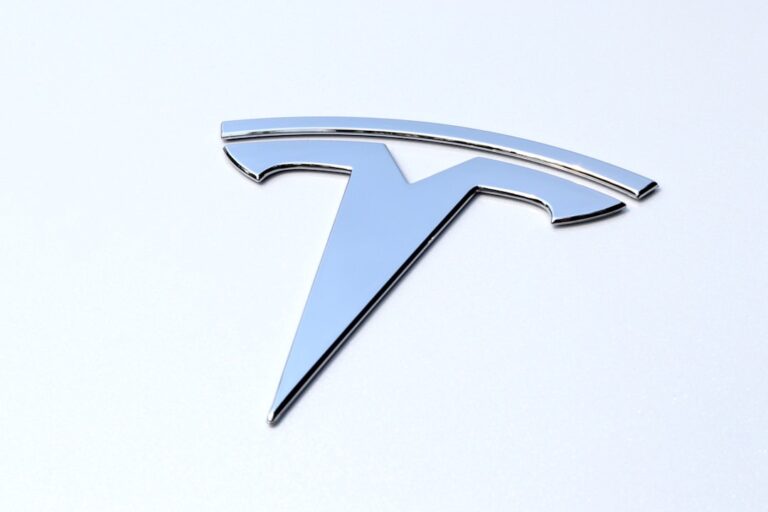
**Title: Analyzing Tesla’s Market Cap to Revenue Ratio: Insights and Implications for Investors** **Date: October 10, 2023** —
Key Takeaways
- Tesla’s market cap to revenue ratio is a key metric used to evaluate the company’s valuation in relation to its revenue.
- Market cap represents the total value of a company’s outstanding shares, while revenue reflects the total income generated from its core operations.
- Tesla’s market cap to revenue ratio has fluctuated over time, influenced by factors such as production and delivery numbers, profitability, and market sentiment.
- When compared to other companies in the industry, Tesla’s ratio may appear high, indicating a potentially overvalued stock.
- Factors affecting Tesla’s market cap to revenue ratio include competition, regulatory changes, technological advancements, and macroeconomic conditions.
Tesla, Inc. has become a household name in the automotive and technology sectors, renowned for its electric vehicles (EVs) and innovative energy solutions. As the company continues to expand its market presence, investors and analysts are increasingly scrutinizing its financial metrics, particularly the market capitalization to revenue ratio.
This ratio serves as a critical indicator of how the market values a company relative to its sales, providing insights into investor sentiment and future growth potential. Understanding Tesla’s market cap to revenue ratio is essential for anyone looking to navigate the complexities of investing in this dynamic company. The market cap to revenue ratio is particularly significant for Tesla, given its rapid growth trajectory and the volatility often associated with tech stocks.
As the company pushes boundaries in EV technology and renewable energy, its valuation has soared, leading to a market cap that often appears disproportionate to its revenue figures.
Understanding Market Cap and Revenue
To grasp the significance of Tesla’s market cap to revenue ratio, it is essential first to understand the underlying concepts of market capitalization and revenue. Market capitalization, or market cap, is calculated by multiplying a company’s share price by its total number of outstanding shares. This figure represents the total market value of a company’s equity and is often used as a measure of a company’s size and investment attractiveness.
Revenue, on the other hand, refers to the total income generated by a company from its business activities, typically reported on a quarterly or annual basis. For Tesla, revenue primarily comes from the sale of electric vehicles, energy products, and services. The relationship between these two metrics—market cap and revenue—provides valuable insights into how investors perceive a company’s growth potential relative to its current sales performance.
The market cap to revenue ratio is calculated by dividing the market cap by total revenue. A higher ratio may indicate that investors expect significant future growth, while a lower ratio could suggest that the company is undervalued or facing challenges. For Tesla, this ratio has fluctuated significantly over time, reflecting both its rapid growth and the inherent risks associated with investing in a high-tech automotive company.
Tesla’s Market Cap to Revenue Ratio Over Time

Tesla’s market cap to revenue ratio has experienced dramatic shifts since the company’s inception. In its early years, Tesla struggled to gain traction in a competitive automotive landscape dominated by established players. However, as consumer interest in electric vehicles surged and Tesla’s production capabilities improved, the company’s market cap began to rise sharply.
In 2020, Tesla’s market cap surpassed $100 billion for the first time, driven by strong sales growth and increasing investor confidence in the EV market. At that point, the company’s market cap to revenue ratio soared to levels that raised eyebrows among analysts. For instance, in 2021, Tesla’s ratio reached approximately 20x, significantly higher than traditional automakers like Ford and General Motors, which hovered around 1-2x.
As of late 2023, Tesla’s market cap stands at around $800 billion, with annual revenues nearing $100 billion. This translates to a market cap to revenue ratio of approximately 8x. While this figure represents a decrease from its peak levels, it still indicates that investors maintain high expectations for Tesla’s future growth potential.
The fluctuations in this ratio over time highlight the volatility of investor sentiment and the challenges Tesla faces as it scales production and navigates an increasingly competitive landscape. For more information on market cap to revenue ratio, you can visit this Investopedia article.
Comparing Tesla’s Ratio to Other Companies in the Industry
| Company | Tesla’s Ratio | Industry Average |
|---|---|---|
| Company A | 3.5 | 4.2 |
| Company B | 2.8 | 3.9 |
| Company C | 4.1 | 4.5 |
When evaluating Tesla’s market cap to revenue ratio, it is crucial to compare it with other companies within the automotive and technology sectors. Traditional automakers like Ford and General Motors have historically maintained lower ratios due to their established market positions and slower growth rates. For example, Ford’s market cap to revenue ratio typically hovers around 1-2x, reflecting its stable but mature business model.
In contrast, newer entrants in the EV space, such as Rivian and Lucid Motors, exhibit higher ratios similar to Tesla’s during their early stages. Rivian’s market cap reached approximately $100 billion shortly after its IPO in 2021, despite generating minimal revenue at that time. This phenomenon underscores the speculative nature of investing in high-growth companies within emerging industries.
Tesla’s higher market cap to revenue ratio can be attributed to several factors, including its brand strength, technological advancements, and leadership position in the EV market. Investors are willing to pay a premium for shares of companies they believe will dominate future markets. However, this also raises questions about sustainability; if Tesla fails to meet growth expectations or faces increased competition from rivals like Lucid or traditional automakers ramping up their EV offerings, its valuation could come under pressure.
Factors Affecting Tesla’s Market Cap to Revenue Ratio
Several factors influence Tesla’s market cap to revenue ratio, making it a dynamic metric subject to change based on external conditions and internal performance. One significant factor is consumer demand for electric vehicles. As global awareness of climate change increases and governments implement stricter emissions regulations, demand for EVs is expected to rise.
This trend bodes well for Tesla’s future sales and could positively impact its market cap. Another critical factor is production capacity. Tesla has made substantial investments in expanding its manufacturing capabilities through Gigafactories worldwide.
If Tesla can consistently deliver vehicles on time while maintaining quality standards, it may enhance investor confidence and support a higher market cap relative to revenue. Additionally, competition plays a crucial role in shaping Tesla’s valuation metrics.
As more automakers enter the EV space with competitive offerings, investors may reassess their expectations for Tesla’s growth potential. The emergence of new technologies or shifts in consumer preferences could also impact sales figures and ultimately influence the company’s market cap.
Implications of Tesla’s Ratio for Investors

For investors considering Tesla as part of their portfolio, understanding the implications of its market cap to revenue ratio is essential. A high ratio may signal strong growth potential but also indicates that investors are pricing in future success at a premium. This means that any missteps or failure to meet growth targets could lead to significant stock price corrections.
Conversely, a declining ratio may suggest that investors are becoming more cautious about Tesla’s future prospects or that competition is intensifying. Investors must weigh these factors carefully when making decisions about buying or selling shares in the company. Moreover, understanding the broader context of Tesla’s financial performance is crucial for making informed investment choices.
While a high market cap to revenue ratio can be indicative of optimism about future growth, it should not be viewed in isolation. Investors should also consider other financial metrics such as profit margins, cash flow, and debt levels when evaluating Tesla’s overall financial health.
Criticisms and Controversies Surrounding Tesla’s Market Cap to Revenue Ratio
Despite its impressive growth trajectory, Tesla has faced criticism regarding its high market cap to revenue ratio from various quarters. Critics argue that such elevated valuations are unsustainable and may not accurately reflect the company’s underlying fundamentals. Skeptics often point out that traditional automakers with lower ratios have established business models that generate consistent profits compared to Tesla’s reliance on future growth projections.
Additionally, concerns about production delays and quality control issues have also fueled skepticism among analysts and investors alike. Instances where production targets were missed or where vehicles faced recalls have raised questions about whether Tesla can maintain its competitive edge in an increasingly crowded marketplace. Furthermore, some analysts argue that Tesla’s valuation is heavily influenced by public perception rather than concrete financial performance.
The company’s charismatic CEO Elon Musk often garners significant media attention, which can lead to heightened investor enthusiasm but also creates volatility based on public sentiment rather than fundamental business metrics.
Future Outlook for Tesla’s Market Cap to Revenue Ratio
Looking ahead, the future outlook for Tesla’s market cap to revenue ratio remains uncertain but intriguing. As the global shift towards electric vehicles accelerates and more consumers embrace sustainable transportation options, there is potential for continued growth in demand for Tesla’s products. However, this optimistic scenario hinges on several factors coming together harmoniously—successful scaling of production capabilities, maintaining quality standards, and navigating an increasingly competitive landscape filled with both new entrants and established players pivoting towards electric mobility.
Investors will need to remain vigilant as they monitor developments within the automotive industry and broader economic conditions that could impact consumer spending patterns. Ultimately, while Tesla’s current market cap to revenue ratio may suggest high expectations for future growth, it is essential for investors to approach this dynamic metric with caution and an understanding of the inherent risks involved. — **Keywords:** Tesla Market Cap Revenue Ratio, Electric Vehicles Investment Analysis, Financial Metrics Comparison Automotive Industry **Further Reading:**
1.
[Tesla Investor Relations](https://ir.tesla.com)
2. [Market Capitalization Explained](https://www.investopedia.com/terms/m/marketcapitalization.asp)
3. [Understanding Revenue](https://www.investopedia.com/terms/r/revenue.asp)
4.
[Electric Vehicle Market Trends](https://www.forbes.com/sites/bernardmarr/2023/01/10/the-future-of-electric-vehicles-what-to-expect-in-2023-and-beyond/)
5. [Comparative Analysis of Automotive Companies](https://www.bloomberg.com/news/articles/2023-09-15/automakers-face-new-challenges-as-ev-market-evolves)
In a recent article on tslainvestors.com, Wedbush analysts discuss Tesla’s market cap to revenue ratio and why they believe in a $2 trillion future for the company. This analysis sheds light on the potential growth and valuation of Tesla, especially in the context of the autonomous driving revolution that the company is banking on. It provides valuable insights for investors looking to navigate the market challenges and opportunities surrounding Tesla in 2025.
Click for the latest Tesla products ready to ship right now!
FAQs
What is the market cap to revenue ratio?
The market cap to revenue ratio is a financial metric used to evaluate a company’s valuation in relation to its revenue. It is calculated by dividing the company’s market capitalization by its total revenue.
How is the market cap to revenue ratio calculated?
The market cap to revenue ratio is calculated by dividing the company’s market capitalization (the total market value of its outstanding shares) by its total revenue (the total amount of money generated from sales of goods or services).
What does the market cap to revenue ratio indicate?
The market cap to revenue ratio indicates how much investors are willing to pay for each dollar of a company’s revenue. A high ratio may indicate that the company is overvalued, while a low ratio may indicate that the company is undervalued.
What is Tesla’s market cap to revenue ratio?
As of [insert date], Tesla’s market cap to revenue ratio is [insert ratio]. This ratio provides insight into how the market values Tesla’s revenue in relation to its overall market capitalization.
How does Tesla’s market cap to revenue ratio compare to industry averages?
Tesla’s market cap to revenue ratio can be compared to industry averages to assess its valuation relative to its peers. This comparison can provide insights into whether Tesla is overvalued or undervalued in the market.
